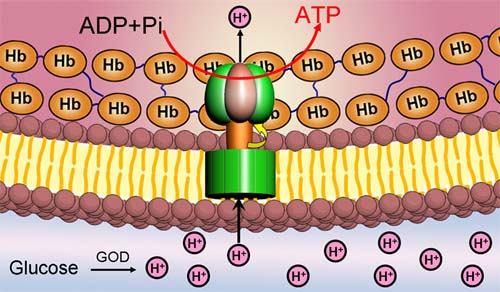| |
The production of adenosine 5′-triphosphate (ATP) is one of the most important chemical reactions in living organisms. The enzyme primarily responsible for the production of ATP is ATP synthase (CF0F1-ATPase), which is a rotary motor protein. This enzyme drives the generation of ATP from ADP and inorganic phosphate by utilizing proton gradients. Recently, understanding of the functioning of ATPase has advanced dramatically to the point where the enzyme is now being studied by scientists interested in developing nanomachines for information storage and energy interconversion. With the financial supports of Chinese Academy of Science, MOST and National Natural Science Foundation, CAS Key Laboratory of Colloid Interface Science and Chemical Thermodynamics have made a progress in the biomimetic assembly of molecular motor. The work has been published in the recent issue of Adv. Mater. (2008, 20, 601-605).
In recent years,this group has made some progresses in assembling molecular motor protein by using “self-assembly” and “layer-by-layer assembly” techniques (Angew. Chem. Int. Ed. 2007,46,6996;Biochem. Biophys. Res. Comm. 2007,354,357). They have reconstituted CFoF1-ATPase in the outer shell of assembled polymer microcapsules containing a lipid bilayer and created a route to generate a proton gradient by varying the pH values within and outside polymer microcapsules. The results showed that ATPase retains their activities and ATP was biosynthesized from ADP and Pi.
More recently, they report the reconstitution of chloroplastic ATPase within lipid-bilayer-coated hemoglobin (Hb) protein microcapsules. A proton gradient is readily produced by the hydrolysis of glucose catalyzed by glucose oxidase (GOD) within the bulk solution outside the capsules. This proton gradient can be maintained for a longer period of time by the addition of glucose, thus enabling the ATPase to be driven for the synthesis of ATP. And the biocompatible microcapsules can be used for the storage of synthesized ATP. Such a biomimetic system may potentially be useful for constructing novel bionanodevices to rotate cargo in the future.
Advanced Materials., (2008, 20, .601-605)

Schematic representation of ATP synthesis catalyzed by ATPase reconstituted in lipid-coated Hb microcapsules , |
|
